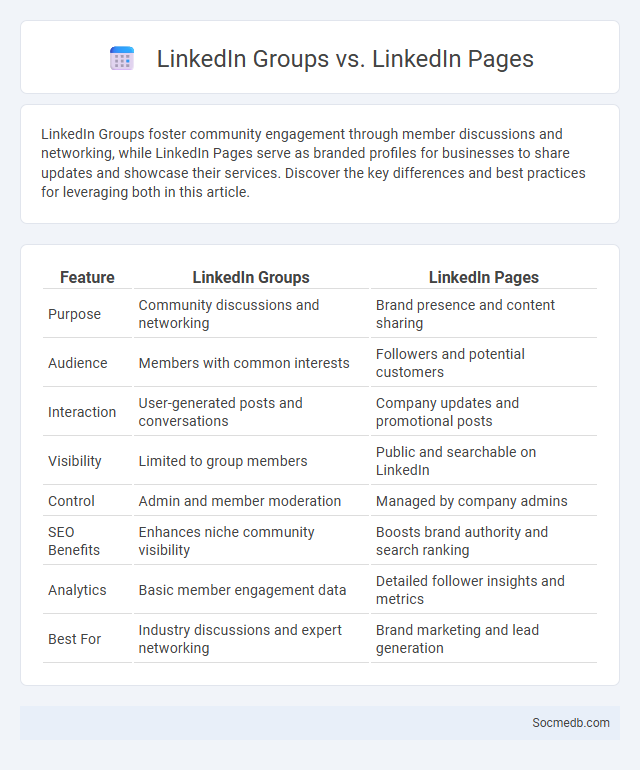
Photo illustration: LinkedIn Groups vs LinkedIn Pages
LinkedIn Groups foster community engagement through member discussions and networking, while LinkedIn Pages serve as branded profiles for businesses to share updates and showcase their services. Discover the key differences and best practices for leveraging both in this article.
Table of Comparison
| Feature | LinkedIn Groups | LinkedIn Pages |
|---|---|---|
| Purpose | Community discussions and networking | Brand presence and content sharing |
| Audience | Members with common interests | Followers and potential customers |
| Interaction | User-generated posts and conversations | Company updates and promotional posts |
| Visibility | Limited to group members | Public and searchable on LinkedIn |
| Control | Admin and member moderation | Managed by company admins |
| SEO Benefits | Enhances niche community visibility | Boosts brand authority and search ranking |
| Analytics | Basic member engagement data | Detailed follower insights and metrics |
| Best For | Industry discussions and expert networking | Brand marketing and lead generation |
Introduction: Understanding LinkedIn Groups, Pages, and Niche Communities
LinkedIn Groups, Pages, and niche communities serve distinct roles in professional networking by fostering targeted engagement and industry-specific discussions. Groups facilitate collaborative conversations among members sharing similar professional interests, while Pages act as brand or company profiles that broadcast updates to followers. Niche communities offer specialized platforms within LinkedIn, enabling professionals to connect deeply around specific skills, sectors, or trends, enhancing visibility and knowledge exchange.
Key Differences Between LinkedIn Groups, Pages, and Niche Communities
LinkedIn Groups offer a space for professionals to engage in industry-specific discussions and network with peers, fostering community-driven conversations. LinkedIn Pages serve as official profiles for businesses or organizations to share content, updates, and promote brand identity, emphasizing public visibility and marketing. Niche communities, often found on platforms beyond LinkedIn, provide highly specialized interactions tailored to specific interests or expertise, enhancing Your ability to connect deeply within targeted topics.
Purpose and Goals: Which Platform Suits Your Objectives?
Choosing the right social media platform depends on your specific marketing objectives and target audience. Instagram excels in visual storytelling and brand engagement, making it ideal for lifestyle and retail businesses focusing on brand awareness. LinkedIn caters to B2B networking and professional content, driving lead generation and industry influence through targeted connections and thought leadership.
Audience Engagement: Where Does the Interaction Thrive?
Audience engagement on social media thrives in interactive formats such as live videos, stories, and polls that encourage real-time participation. Platforms like Instagram, TikTok, and Facebook offer algorithm-driven content distribution that prioritizes posts generating high engagement rates from users. User-generated content, timely responses from brands, and personalized interactions significantly boost engagement metrics across channels.
Content Strategy: What Works Best for Each Platform?
Tailoring your content strategy to each social media platform maximizes engagement and reach by leveraging their unique algorithms and user preferences. Instagram favors visually appealing, short-form video and image posts with relevant hashtags, while LinkedIn performs best with professional articles, detailed insights, and thought leadership content. Facebook's algorithm prioritizes interactive posts like polls, live videos, and community-driven content, so optimizing your approach based on these platform-specific characteristics helps your brand connect effectively with its target audience.
Networking Opportunities: Building Connections in Each Space
Social media platforms such as LinkedIn, Twitter, and Instagram offer diverse networking opportunities that help professionals build industry-specific connections efficiently. By engaging in niche groups, participating in discussions, and sharing relevant content, users enhance visibility and credibility within their field. Leveraging these networks accelerates career growth, fosters collaborations, and opens doors to new business ventures.
Branding and Visibility: Maximizing Your Organization’s Reach
Social media platforms like Facebook, Instagram, and LinkedIn enable organizations to build strong brand identities by consistently sharing tailored content and engaging with target audiences. Leveraging strategic posting schedules, influencer partnerships, and hashtag campaigns enhances visibility, driving higher user interaction and brand recognition. Optimizing profiles with relevant keywords and utilizing analytics tools helps refine outreach efforts, maximizing overall organizational reach and impact.
Moderation and Management: Tools and Challenges
Effective social media moderation and management rely on advanced tools like AI-driven content filters, real-time monitoring dashboards, and automated response systems to maintain community standards and enhance user engagement. Challenges include balancing free speech with harmful content removal, handling large volumes of user interactions, and adapting to evolving platform policies and regulations. Maintaining Your brand reputation requires continuous investment in training moderators and leveraging analytics to improve decision-making processes.
Analytics and Growth Tracking: Measuring Performance
Social media analytics and growth tracking offer critical insights into engagement metrics, audience behavior, and content effectiveness, enabling data-driven decision-making. Utilizing tools like Google Analytics, Facebook Insights, and Instagram Analytics, you can measure key performance indicators (KPIs) such as reach, impressions, click-through rates, and follower growth. Monitoring these metrics regularly helps optimize strategies to enhance your brand's visibility and maximize social media ROI.
Choosing the Right Platform: Factors to Consider
Selecting the appropriate social media platform depends on audience demographics, content type, and business goals. Analyze user engagement patterns, platform algorithm preferences, and advertising options to enhance reach and conversion rates. Prioritize platforms where target customers are most active to maximize marketing ROI and brand visibility.
 socmedb.com
socmedb.com